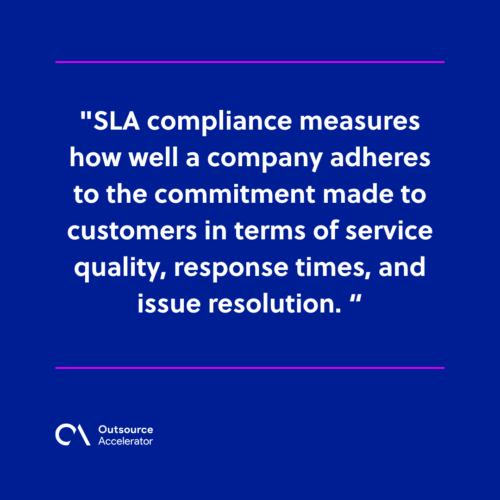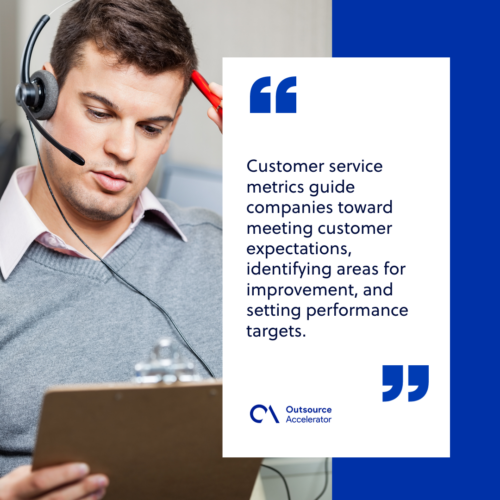Customer service metrics to remember

In the relentless pursuit of exceptional customer service, businesses have discovered a vital compass that guides their efforts – customer service metrics.
These quantifiable measures provide valuable insights into how well a business meets customer needs and expectations and where improvements can be made.
This article dives into the world of customer service metrics. We’ll discuss what they are, why they matter, and how to use them to enhance your customer service strategy effectively.
What are customer service metrics?
Customer service metrics are specific measurements and indicators used to assess and evaluate various aspects of a company’s customer service performance.
These metrics can be quantitative or qualitative. They provide calculable data and insights into different aspects of customer service and how well the business is meeting needs and expectations.
Customer service metrics serve as benchmarks for performance. They help companies monitor their progress in achieving service goals.
By tracking and analyzing customer service metrics, companies can identify strengths and weaknesses, make informed decisions, and ultimately enhance support efforts.

Importance of customer service metrics
Customer service metrics are crucial in assessing and improving the overall customer experience.
Their importance can be attributed to the following main factors:
Performance evaluation
Customer service metrics provide a quantitative assessment of how well a company is meeting customer needs and expectations. This data helps identify areas of improvement and set performance targets.
Customer satisfaction
Customer service metrics enable businesses to gauge how satisfied their customers are with the service provided. Understanding this satisfaction level is critical for retaining the trust of existing customers and attracting new ones.
Capacity planning
By studying historical data and predicting trends, companies can allocate resources effectively. This ensures sufficient staffing levels during peak hours and maintains high service standards.
6 customer service metrics to keep in mind
Here are some critical customer service metrics to keep in mind:
1. First Contact Resolution (FCR)
FCR measures the percentage of customer requests or issues resolved during the first interaction with the customer service team. A high FCR rate indicates efficient and effective service delivery.
2. Average Handle Time (AHT)
AHT is the average amount of time it takes to handle a customer inquiry or issue. It measures the efficiency of the customer service team in resolving issues and responding to customer requests.
A lower AHT indicates quicker problem resolution and improved customer service.
A minor metric related to this is the First Response Time (FRT). FRT measures how fast it takes for an issue to be resolved during the first interaction.
3. Customer Satisfaction Score (CSAT)
CSAT is a customer service metric used to measure the level of customer satisfaction with the service provided by a company.
Respondents are typically asked to choose a rating on a scale, such as from 1-5 or 1-10. CSAT provides immediate feedback on individual interactions.
4. Net Promoter Score (NPS)
NPS measures customer loyalty and how likely they are to recommend a company’s products or services to others. It’s usually measured by asking customers to choose from a scale of 0-10.
NPS categorizes respondents as follows:
- Promoters (score 9-10)
- Passives (score 7-8)
- Detractors (score 0-6)
5. Service Level Agreement (SLA) Compliance
SLA compliance measures how well a company adheres to the commitment made to customers in terms of service quality, response times, and issue resolution.
This customer service metric is especially important for businesses offering time-sensitive services.

6. Customer Effort Score (CES)
CES assesses the ease of the customer’s experience. For example, it asks, “How simple was it to fix your problem today?”
A lower score indicates higher customer effort, which can be a sign of potential dissatisfaction. This metric helps companies optimize their customer service process to reduce customer effort and enhance the overall experience.
Remember that the choice of customer service metrics should align with your business goals and the specific aspects of customer service you aim to improve.
A combination of these metrics can provide a holistic view of your customer service performance and guide your efforts to enhance the customer experience.
Tools for tracking customer service metrics
Productively tracking customer service metrics requires the right tools and software to collect, analyze, and visualize data.
Some popular options for doing so include:
Qualtrics
Qualtrics is a leading experience management platform that provides businesses with a comprehensive suite of tools, aiding in:
- Collecting
- Analyzing
- Acting on customer and employee feedback
This platform enables companies to measure, analyze, and improve customer experiences, employee experiences, brand experiences, product experiences, and market research.
HubSpot Service Hub
HubSpot’s Service Hub is a comprehensive customer service software designed for businesses of all sizes, from small to enterprise. It provides a range of features and tools to help businesses measure and improve their customer service metrics.
Its key features include:
- Conversational tools
- Help desk automation
- Knowledge base functionality
- Customer feedback and surveys
- Reporting and analytics
Zendesk
Zendesk’s customer service software includes a wide range of metrics for tracking customer interactions, including first response time, resolution time, and customer satisfaction.
The software also offers reporting and analytics tools to help companies identify trends and areas for improvement.
These are just a few examples of the many tools for tracking customer service metrics. When selecting a tool, it’s important to consider the specific metrics you want to track, the size of your company, and your budget.
Making informed decisions with customer service metrics
Customer service metrics guide companies toward meeting customer expectations, identifying areas for improvement, and setting performance targets. The data obtained enables businesses to tailor their service accordingly.

It’s worth noting that customer service metrics should not be viewed in isolation but rather as part of a holistic approach to customer experience management and customer-centricity.
Metrics provide mostly quantitative data but need to be complemented with qualitative feedback and insights from customers. By combining metrics and feedback, businesses can gain a comprehensive understanding of the customer experience.
With the right tools and a deep understanding of customer service metrics, your organization can navigate the complex waters of customer needs.







 Independent
Independent




